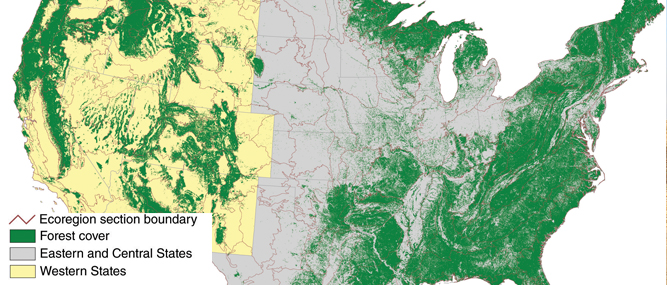The annual national report of the Forest Health Monitoring (FHM) program of the U.S. Forest Service presents forest health status and trends from a national or multi-state regional perspective using a variety of sources. It also introduces new techniques for analyzing forest health data, and summarizes results of recently completed Evaluation Monitoring projects funded through the FHM national program.
The 2018 report, by the Forest Service’s Southern Research Station and edited by two professors from the department of forestry and environmental resources at North Carolina State University, was issued in June 2019. It identifies geographic patterns of insect and disease activity, compares drought and surplus moisture conditions, examines tree mortality, and looks at the Eastern United States to identify forests with low or high levels of invasive plants.
Data related to insects and disease found geographic hot spots of forest mortality were associated with bark beetle infestations in the West and with emerald ash borer and southern pine beetle in the East. Hot spots of defoliation were associated with gypsy moth and other insects and white pine needle damage in the East, and with western spruce budworm in the West.
In 2017, the number of satellite detected forest fire occurrences recorded for the conterminous states was the fifth most in 17 years and the most since 2014. Ecoregion sections in the Pacific Northwest, the northern Rocky Mountains, and California had the highest forest fire occurrence density. Geographic hot spots of high fire occurrence density were detected in these same areas as well as in the Southeast and southern Arizona. Ecoregion sections in southern, central, and northern California; the Cascade Mountains of Oregon and Washington; and northern Idaho and northwestern Montana experienced greater fire occurrence density than normal compared to the previous 15-year mean and accounting for variability over time.
Much of the Southwest and parts of southern California had extreme drought conditions in 2017, while portions of the central Midwest, northern Great Plains, and the Southeast had moderate to severe drought. Areas near the Great Lakes, west of the Appalachian Mountains, and in the interior Northwest had moderate to extreme moisture surplus conditions. Analyses of longer term (3-year and 5-year) conditions show that much of the West had undergone long term drought conditions, as had coastal New England and a swath of the South extending from western North Carolina through Georgia and Florida. The remainder of the country generally experienced at least mild moisture surplus conditions for these longer periods, with severe or extreme moisture surplus in Texas, the northern Midwest, and along the coasts of North and South Carolina.
An analysis of Central and Eastern States found that in most areas, tree mortality is low relative to tree growth; areas of highest mortality occur mostly in riparian forests of the Great Plains. Specifically, the highest ratios of annual mortality to gross growth occurred in ecoregion sections located in South Dakota, North Dakota, Nebraska, northwestern Ohio and eastern Michigan, north-central Arkansas, eastern Oklahoma, southeastern Kansas, and east Texas. Similar analyses were conducted for the Pacific Coast states; throughout much of this area, mortality relative to growth was low, but in parts of southern California, mortality exceeded growth. Areas of highest annual mortality were in southern California, northeastern Utah, and southeastern Montana. However, results for the western U.S. were considered preliminary.
Invasive plant species can cause a variety of undesirable changes in forest health simply by altering forest species composition, and a large proportion of rural forest in the East already contains harmful invasive plant species. Half of the total area of 74 forest types was found to be invaded, with invasions almost twice as likely on privately owned land than on publicly owned land.
The FHM program, in cooperation with forest health specialists and researchers inside and outside the Forest Service, continues to investigate a broad range of issues relating to forest health using a wide variety of data and techniques. This report presents some of the latest results from ongoing national scale detection monitoring and smaller scale environmental monitoring efforts by FHM and its cooperators.
For more information about efforts to determine the status, changes, and trends in indicators of the condition of U.S. forests, visit the FHM website at www.fs.fed.us/foresthealth/fhm.




